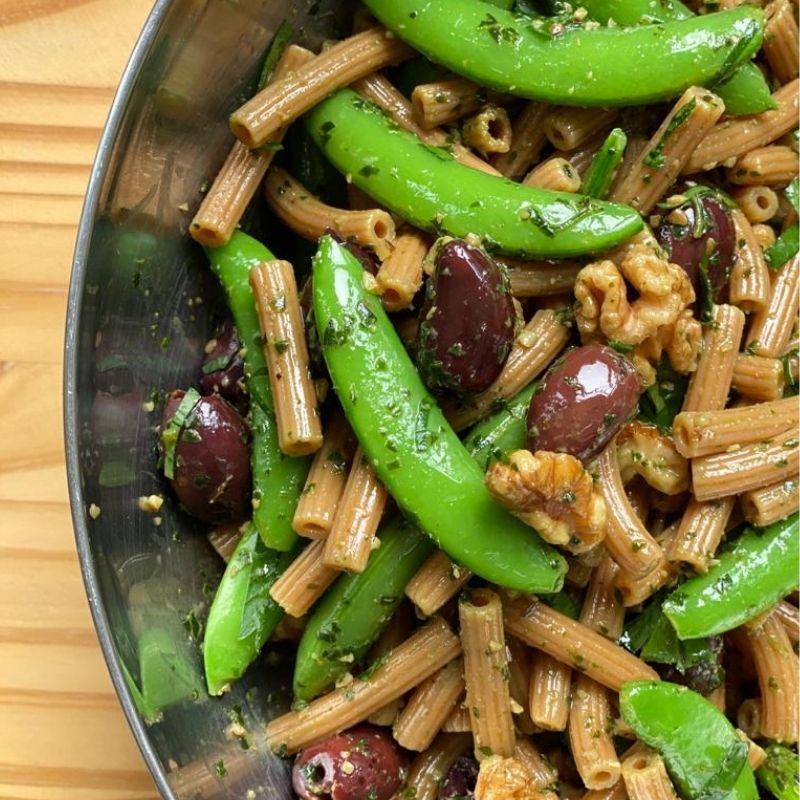
Easy Gluten Free Pasta Salad Made in 20 Minutes
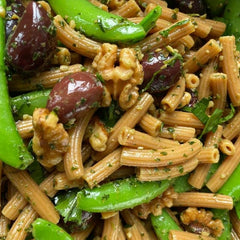
Gluten-free has become much more accessible in Hong Kong in the past years. There are quite a lot of gluten free pasta brands available (which we will introduce in a bit!) and as a consumer, we can pick and choose the gluten-free pastas we like!
In this blog, we have put together a quick gluten-free pasta guide for gluten-free rookies.
As we kind of know gluten-free sounds like a healthier option, today we want to go deeper into the commonly asked questions to clear the "?" we have around gluten-free so that you can make conscious decisions when you do choose gluten-free products.
Is Gluten-Free Pasta Healthy?
The quick answer to this is "yes". Gluten is known to cause inflammation and avoiding gluten may help you ease the discomfort that you may or may not be aware of. Having said that, there are many unhealthy gluten-free foods out there and it is important to know that not all gluten-free foods are saints (especially the packaged foods on supermarket shelves).
As we covered in the "What’s In A Gluten Free Bread?" blog, reading the ingredient list on the food label is crucial. Many packaged foods contain way too much refined carbs, sugar and 'E numbers' to mask the flavor and texture of gluten-free that I would say some gluten-free options have become unhealthy choices.
What Is Gluten-Free Pasta Made Of?
Most gluten-free pastas are made using a blend of different grains or legumes. The typical ones are corn, millet, buckwheat, quinoa, rice, amaranth, chickpeas and lentils.
As pasta doesn't need to rise and be fluffy like bread, it is relatively easy to replace wheat with other grains that do not contain gluten to make a tasty pasta. Therefore, compared to gluten-free baked items, it is easier to find a healthy gluten-free pasta but still, checking the ingredients list is a MUST!
Does Gluten-Free Pasta Taste Different From Wheat Pasta?
The good news is that gluten-free pastas that taste pretty good are available nowadays. In my opinion, the gluten-free pastas that contain rice and corn tend to have a texture closer to wheat pastas.
If the pasta is made out of wholegrains, it will have a rather rough texture compared to the refined grains. For example, a pasta made out of white rice will taste closer to a wheat pasta that you are used to rather than the gluten free pasta made with brown rice.
The gluten-free pastas made from legume flours will have a brittle and dry texture.
Is Gluten-Free Pasta Low Carb?
The nutritional value of gluten-free pasta can vary significantly based on what types of grains or legumes are used in it.
The legume pastas (chickpea pasta, lentil pasta, green pea pasta, black bean pasta, etc.) will have lower carb and higher protein profile - however the compromise will be the texture of the pasta.
The gluten-free pastas that contain grains like rice, potato, corn will NOT be a low carb option.
A compromise can be gluten-free pastas made out of whole grains such as buckwheat and quinoa, which can have about 10-15% less carbs compared to the refined carbs gluten-free pastas. However, the downside may be the rough texture of the cooked pasta.
Does Gluten-Free Pasta have Low Calories?
Yes - if, it is a legume or a wholegrain gluten-free pasta. If it's a refined grain gluten-free pasta, the calories will be similar to a normal wheat pasta. If your goal is weight management, you should choose a pasta that is not only gluten-free but is also high fiber and low-carb like we've mentioned in above.
Which Is The Best Gluten-Free Pasta?
It depends on what you are looking for. If you want a gluten-free pasta that mimics the white pasta that you are used to, go for the gluten-free pastas that contain rice, corn or potatoes. However, if your goal is to truly improve your health, the better choice will be the whole grain and legume gluten-free pastas.
Below is a guide of the brands we recommend according to what type of gluten-free pasta you are going for.
What Are The Gluten-Free Pasta Brands?
Gluten-free pastas that are closer to white pastas:
How to Cook Gluten-Free Pasta?
The cooking process is pretty similar to the wheat pasta. Depending on the size of the pasta, the cooking time will vary from about 8 to 12 minutes.
Here is a gluten-free pasta recipe that I love because it's simple, easy and nutritious. It is a gluten-free pasta salad and of course the sauce is not only gluten-free but also dairy-free too!
Easy Gluten-Free Pasta Salad with Dairy-Free Pesto Sauce
(made in 20 minutes!)
Serves 4 as a main dish
250g, gluten free chickpea pasta
100g, dairy free walnut pesto
250g, snap peas, trimmed
The quick answer to this is "yes". Gluten is known to cause inflammation and avoiding gluten may help you ease the discomfort that you may or may not be aware of. Having said that, there are many unhealthy gluten-free foods out there and it is important to know that not all gluten-free foods are saints (especially the packaged foods on supermarket shelves).
As we covered in the "What’s In A Gluten Free Bread?" blog, reading the ingredient list on the food label is crucial. Many packaged foods contain way too much refined carbs, sugar and 'E numbers' to mask the flavor and texture of gluten-free that I would say some gluten-free options have become unhealthy choices.
What Is Gluten-Free Pasta Made Of?
Most gluten-free pastas are made using a blend of different grains or legumes. The typical ones are corn, millet, buckwheat, quinoa, rice, amaranth, chickpeas and lentils.
As pasta doesn't need to rise and be fluffy like bread, it is relatively easy to replace wheat with other grains that do not contain gluten to make a tasty pasta. Therefore, compared to gluten-free baked items, it is easier to find a healthy gluten-free pasta but still, checking the ingredients list is a MUST!
Does Gluten-Free Pasta Taste Different From Wheat Pasta?
The good news is that gluten-free pastas that taste pretty good are available nowadays. In my opinion, the gluten-free pastas that contain rice and corn tend to have a texture closer to wheat pastas.
If the pasta is made out of wholegrains, it will have a rather rough texture compared to the refined grains. For example, a pasta made out of white rice will taste closer to a wheat pasta that you are used to rather than the gluten free pasta made with brown rice.
The gluten-free pastas made from legume flours will have a brittle and dry texture.
Is Gluten-Free Pasta Low Carb?
The nutritional value of gluten-free pasta can vary significantly based on what types of grains or legumes are used in it.
The legume pastas (chickpea pasta, lentil pasta, green pea pasta, black bean pasta, etc.) will have lower carb and higher protein profile - however the compromise will be the texture of the pasta.
The gluten-free pastas that contain grains like rice, potato, corn will NOT be a low carb option.
A compromise can be gluten-free pastas made out of whole grains such as buckwheat and quinoa, which can have about 10-15% less carbs compared to the refined carbs gluten-free pastas. However, the downside may be the rough texture of the cooked pasta.
Does Gluten-Free Pasta have Low Calories?
Yes - if, it is a legume or a wholegrain gluten-free pasta. If it's a refined grain gluten-free pasta, the calories will be similar to a normal wheat pasta. If your goal is weight management, you should choose a pasta that is not only gluten-free but is also high fiber and low-carb like we've mentioned in above.
Which Is The Best Gluten-Free Pasta?
It depends on what you are looking for. If you want a gluten-free pasta that mimics the white pasta that you are used to, go for the gluten-free pastas that contain rice, corn or potatoes. However, if your goal is to truly improve your health, the better choice will be the whole grain and legume gluten-free pastas.
Below is a guide of the brands we recommend according to what type of gluten-free pasta you are going for.
What Are The Gluten-Free Pasta Brands?
Gluten-free pastas that are closer to white pastas:
- Rummo Pastas (except "Rummo Lentil Gluten-Free Maccheroncelli Rigati Nº 7" & "Rummo Gluten-Free Fusilli Al Ceci Nº 48" )
- Doves Farm Gluten-Free Brown Rice Pastas
- Doves Farm Gluten-Free Organic Maize and Rice Pastas
- Rummo Lentil Gluten-Free Maccheroncelli Rigati Nº 7
- Rummo Gluten-Free Fusilli Al Ceci Nº 48
- Clearspring Organic Gluten Free Pastas
- Amisa Organic Gluten-Free Buckwheat Spaghetti
- Rinatura Organic Legume Fettuccine
- Gafell Low Carb Bean Pastas
- REWE Bio Organic Gluten Free Pasta
How to Cook Gluten-Free Pasta?
The cooking process is pretty similar to the wheat pasta. Depending on the size of the pasta, the cooking time will vary from about 8 to 12 minutes.
Here is a gluten-free pasta recipe that I love because it's simple, easy and nutritious. It is a gluten-free pasta salad and of course the sauce is not only gluten-free but also dairy-free too!
Easy Gluten-Free Pasta Salad with Dairy-Free Pesto Sauce
(made in 20 minutes!)
Serves 4 as a main dish
250g, gluten free chickpea pasta
100g, dairy free walnut pesto
250g, snap peas, trimmed
150g, pitted whole olives
Instructions
- Fill a medium pot with 2L of water and bring it to boil. Add a teaspoon of salt and boil the chickpea pasta for 10 minutes.

- Add the sweet peas to the same pot and boil for another minute. Once the sweet peas gain a bright green color, remove the pot from the flame and drain off the water in a strainer.


- While it's still hot, place the cooked pasta and peas in a large mixing bowl and add the pesto sauce, mix well. Add the walnuts and olives and toss.
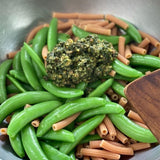
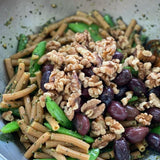
- When you are ready to serve. add the chopped Italian parsley leaves and mix well.


- Serve hot or at room temperature! You can store this in the refrigerator in an airtight container for up to 2 days.

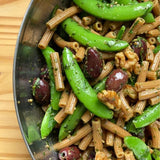

Leave a comment